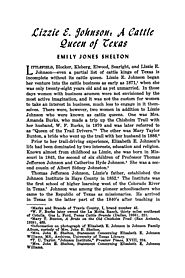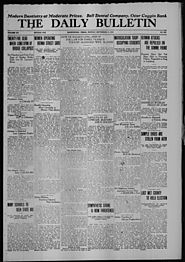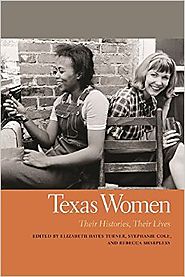-
About
- About Listly
- Community & Support
- Howto
- Chrome Extension
- Bookmarklet
- WordPress Plugin
- Listly Premium
- Privacy
- Terms
- DMCA Copyright
- © 2010-2024 Boomy Labs

Listly by UTA-P
A look at women of Texas history who weren't afraid to get their hands dirty. Women who proved to be equal to man in agriculture/farming, politics, and architecture.

The Texas State Historical Association Quarterly Report includes "Papers read at the meetings of the Association, and such other contributions as may be accepted by the Committee" (volume 1, number 1). These include historical sketches, biographical material, personal accounts, and other research. Index is located at the end of the volume starting on page 533.
"A Cattle Queen of Texas" They called her. Lizzie Johnson's ability to get her hands dirty made her deserving of that title.

Daily newspaper from Brownwood, Texas that includes local, state, and national news along with advertising.
Henrietta King
![GOODNIGHT, MARY ANN DYER [MOLLY]](http://media.list.ly/production/294249/1844965/item1844965_185px.jpeg?ver=2977497691)
GOODNIGHT, MARY ANN DYER MOLLY. Mary Ann (Molly) Goodnight, wife of Texas rancher Charles Goodnight and daughter of Joel (or Joe) Henry and Susan Lynch (Miller) Dyer, was born in Madison County, Tennessee, on September 12, 1839. She was called Mary by her husband but known as Molly to others. The first lady of the Palo Duro Canyon was at one time the only woman on the vast JA Ranch established by Goodnight and John Adair in 1877. Enshrined in the minds and hearts of countless cowboys as the Mother of the Panhandle, Molly became doctor, nurse, homemaker, spiritual comforter, sister, and mother to the hands who worked for her husband. Such a diversity of responsibility would have proved difficult on any ranch in Texas, but Molly's home counted as one of its borders a solitary canyon 1,500 feet deep, 10 miles wide and almost 100 miles long, where once Comanche Indians roamed and camped. Mary Ann Dyer knew something about the hard, frontier existence of Texas even before she married and settled on the rim of the Palo Duro. She was fourteen years old when she was brought to Fort Belknap, Texas, in 1854 by her father and mother. Molly's father was a prominent lawyer in Tennessee before he settled his family in the Eastern Cross Timbers region of Texas. Sometime after 1854 her parents died, and Molly had to take care of her five brothers. In the late 1850s or early 1860s she worked as a schoolteacher to support her three youngest brothers. During the Civil War the elder Dyer brothers served in the Confederacy. Molly met Charles Goodnight at Fort Belknap about 1864. In the mid-to-late 1860s she moved to Weatherford, Texas, to teach.

Texas Women: Their Histories, Their Lives (Southern Women: Their Lives and Times Ser.) [Stephanie Cole, Rebecca Sharpless, Elizabeth Turner, Nancy E. Baker, Associate Professor Juliana Barr, Professor Angela Boswell, Assistant Professor Jessica Brannon-Wranosky, Light T. Cummins, Victoria H. Cummins, Mary Ellen Curtin, W. Marvin Dulaney, Gabriela González, Ruth Hosey Karbach, Associate Professor Renee M. Laegreid, Paula Mitchell Marks, Judith N. McArthur, Laura Lyons McLemore, Bianca Mercado, Jennifer Ross-Nazzal, Assistant Professor Robin C. Sager, Professor Harold L. Smith, Professor Jean A. Stuntz, Assistant Professor Kelli Cardenas Walsh, Professor Eric Walther] on Amazon.com. FREE shipping on qualifying offers. Texas Women: Their Histories, Their Lives engages current scholarship on women in Texas, the South

DE LEÓN, PATRICIA DE LA GARZA (1775–1849). Patricia de la Garza De León, early settler, who with her husband, empresario Martín De León, developed the city of Victoria, was born in Soto la Marina, Nuevo Santander (now Tamaulipas), Mexico, in 1775. Her father, Felipe de la Garza, served as commandant for the Spanish government. In 1795 Patricia and Martín were married, and they started a ranch near Cruillas, Nuevo Santander. Between 1798 and 1818 Doña De León gave birth to ten children. In 1805 the De Leóns moved to the east bank of the Aransas River, north of Corpus Christi. They moved several more times before 1824, when they were granted land by the newly independent Mexican government. Using money they had earned from the sale of livestock and the $9,800 Patricia inherited from her father, they established a colony on the bank of the Guadalupe River in Southwest Texas. Martín named the settlement Guadalupe Victoria in honor of the first president of Mexico; it was the only predominantly Mexican colony in Texas.

Very informational and provided nearly all needed images and topics on women in politics.